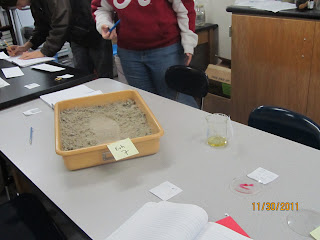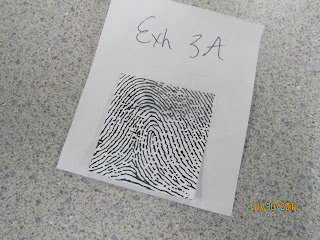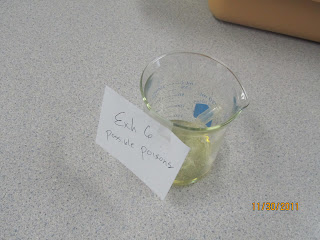A residence was broken into the night of November 30th. Although no bodies were found at the scene, there are enough evidence to point to the victim and its attacker.
This is the untampered crime scene.
There is a
- footprint
- two ripped up notes
- hair sample
- a fiber
- a high heel
- a pair of earrings
- possible poison
- a fingerprint to lift
We all worked with different part of the investigation. I took over the hair and fiber with Vicki. The hair was very short and multicolored, and after examining it closely under the microscope we determined for it to be the dog, Tyler's hair. The fiber was a ripped piece of green nylon.
- Tyrese Jefferson
- Jeb Sampson
- Sandra O'Connor(whose bloodtype was not listed
- Courtney Smith
- Jet Trong (Also unlisted)
The other teammembers put the note back together and one of them read "You will never find her!" and the other read "Please help me". It can be deducted that the culprit had written the first note and the victim the second.
The note asking for help had matched Tyese Jefferson's handwriting found on her profile.
We concluded that because of a few qualities found in her handwriting such as
- the capital letter has more spacing in between the next letter than the others
- her y's are lavishing, which may mean that the letter h may have the same effect
- her letter 'n' is not detailed, having the pencil draw an arch instead of a proper 'n'
The second note is most likely to have been written by Smokey Johnson.
Not many of the letters on his profile match those on the notecard, but there is one definite feature and that is the letter "e". The notecard and Smokey Johnson both has the rounded "e" that others don't have. The letter "n" was also a deciding point because his spacing between the line of the "n" and the arch was far apart.
Furthermore, the two sets of fingerprints left at the scene matched the two people.
This is a plain whorl, the quality only found in Smokey Johnson's fingerprint.
The ulnar loop is only apparent in Sandra O'Connor and Tyese Jefferson's prints.
From the handwriting analysis is it most likely Tyese's print.
Lastly, the possible poison was tested to be iodine.
There were a few extra information we had gathered:
- High Heel
- Size 8
- The shoe straps with a belt, meaning that it'll be difficult for it to just fall off.
- Gold Earring
- The post is bent, which means that it could be uncomfortable and unnatural to have it in your ear.
- Skateboard shoe
- Men's size seven
Now we knew the truth behind what had occured that night.
Smokey Johnson Nov. 30 9PM
This is it. This is the night I will finally get revenge on my beloved Tyese. I'm upset it has to be like this. You brought this on yourself Tyese, remember that...
A few months back, Smokey attended a certain counseling class after punching his co-worker at work. In that one session he fell in love with his counselor, Tyese Jefferson who had faced him with true kindness. That was the day he started stalking Tyese and observing her, catching her every minute of every day. He thought that she was the one. Until the day a restraining order had been held against him by his true love, Tyese. He couldn't believe that the woman he loved had eliminated him from her life. So he planned revenge, to get back at her for her wrong-doing. He stopped in front of a house too familiar to him, more familiar than his own. Walked around to the back where he had usually observed Tyese from and snuck inside by the window, leaving a distinct footprint underneath...
Tyese Jefferson November 30th
"Ow ow ow.. what is wrong with this earring!"
Tyese was walking home from a party, all dressed up for the occasion but not having as much fun as she was expecting to have. It may be stress from work, stress from fear... she promised herself that as a professional she would not live in fear of that man. What she needed was to get some rest and to take off the stupid earring. She had accidentally stepped on it this morning but couldn't leave them behind because it matched her dress completely. She wore a green nylon cardigan over the dress because it was almost December and cold enough she could see her breath stay in the air. Her high heels were clanking against the cement as she walked in the quiet street. She stopped to pet Tyson, the friendly neighborhood dog that she loved. After a few minutes, she went on to return to her home.
As soon as she turned the key and stepped in the door, Tyese took off her earring. The relief from its removal swept through her entire body, the tensity escaping from her pierced ear. She undid the belt loop of her high heel and went on to remove the other when she heard a noise that was not from outside, but from inside her home. The tensity returned, and she looked up to see her utmost fear approaching her. Tyese thought to run outside but with one three inch heel and the other barefoot, she realized it was a futile attempt. Instead she scribbled a note saying "Someone please help me!" and then was grabbed by the man. Through the struggle, her favorite cardigan was ripped and her hands and legs were bound together with no promise of escape. She watched him as he scribbled down a note on the counter. She couldn't see what it said, but knew that it was not good.
Smokey Johnson- November 30th
"You will never find her!" After finishing the note, he went into the bathroom. Not to "do his business" of course, but to look at the iodine bottle and wonder what to do with it. From his observation(stalking) he knew that without this to regulate her Thyroid problem, it could cause Tyese a lot of suffering and possible death. He was seeking for revenge, it would be perfect. He smiled, left the bathroom empty handed and proceeded on relocating Tyese to a secluded place until her slow, horrible death.
The job for the forensics team was over. It was up to the police to find Tyese, dead or alive. The only thing we could do was to hope that she was still safe.





















































